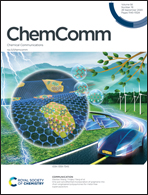In vivo and in vitro protein mediated synthesis of palladium nanoparticles for hydrogenation reactions†
Abstract
We report the biosynthesis of size confined palladium nanoparticles (Pd-NPs). The 2–3 nm size Pd-NPs were grown in 12-mer protein stable protein 1 (SP1), which serves as a template for the NP formation. We further show that by controlling the protein expression levels in the cells we can alter the cells’ catalytic activity. The in vivo grown Pd-NPs were utilized in a hydrogenation reaction, converting acetylene feedstock into ethylene and ethane. The presented concept can be further used for a wide range of applications by exploiting the synergetic effect of the biotic elements with the abiotic ones.



 Please wait while we load your content...
Please wait while we load your content...